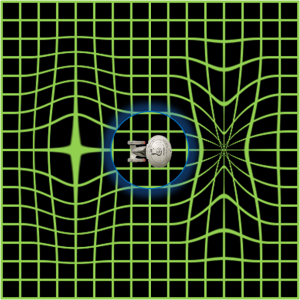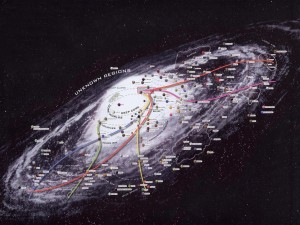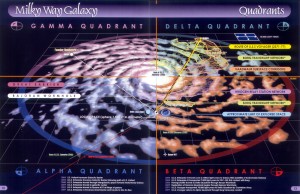First, we need to define what warp drive and hyperspace are. Now, I’m not a physicist, just a fan. No matter how much research I do, I’ll never completely understand the science behind the technology, but I’m going to do my best to define these two terms for you.
WARP DRIVE
 Warp drive is one method of faster-than-light propulsion. The ship sits in a bubble of normal space as the rest of space “folds” (hence the name “warp”) to allow the ship to travel between two places at a faster rate of speed. Think of it as a piece of paper with a dot at the top of the page and a dot at the bottom of the page: when the page is flat, there is a certain distance between the two dots; if you accordion-fold the page, the distance is significantly decreased. In this way, a ship is able to move at a speed faster than the speed of light.
Warp drive is one method of faster-than-light propulsion. The ship sits in a bubble of normal space as the rest of space “folds” (hence the name “warp”) to allow the ship to travel between two places at a faster rate of speed. Think of it as a piece of paper with a dot at the top of the page and a dot at the bottom of the page: when the page is flat, there is a certain distance between the two dots; if you accordion-fold the page, the distance is significantly decreased. In this way, a ship is able to move at a speed faster than the speed of light.Also, instead of the ship moving extremely fast, the ship remains stationary in its bubble of space as the rest of space moves at a hyper-accelerated speed.
HYPERSPACE
Hyperspace is another method in which a spacecraft can fly at a speed faster than light. However, hyperspace works in a way very different than warp drive. Hyperspace is an alternate region of space that co-exists with our own universe that can be used to travel faster than the speed of light. In the Star Wars universe, hyperspace allows ships to travel extremely fast; however, travel is still constrained by the position of objects in the galaxy. Pilots have to abide by standard hyperspace routes, otherwise they could fly straight through the middle of a star.
From our good friend Wikipedia:
Generally speaking, the idea of hyperspace relies on the existence of a separate and adjacent dimension. When activated, the hyper drive shunts the starship into this other dimension, where it can cover vast distances in an amount of time greatly reduced from the time it would take in “normal” space. Once it reaches the point in hyperspace that corresponds to its destination in real space, it re-emerges.Unlike warp drive, which is basically limited to Star Trek, hyperspace tends to pop up in many more places than just Star Wars, including Stargate and Babylon 5. In fact, Star Trek uses an alternate region of space called “subspace” as a way to communicate at faster-than-light speeds, however, subspace is not used for travel.
COMPARISON
It seems that hyperspace is faster than warp drive. In the Star Wars universe, the trip that the Millennium Falcon took from Tatooine to Alderaan (from the outer rim of the galaxy to the inner core) probably only took a few hours. Compare that to the 70+ year journey that the USS Voyager was facing for a slightly longer cross-galaxy journey. In this way, hyperspace is superior to warp drive.
However, as Han Solo famously said, “hyperspace ain’t like dusting crops”. It takes complex calculations and planning to pilot a ship through hyperspace without incident. Warp drive is less risky, allowing ships like the USS Voyager to navigate unknown space in a nearly straight line.
Also, a theoretical warp drive has already been proposed. The Alcubierre drive, introduced in 1994, is a way to create the “warp bubble” that allows the ship to travel through space without breaking the theory of relativity. However, there is no known way to create a warp bubble or to dissipate it, so it only remains a hypothetical concept for now. While we have yet to discover alternate layers of space, we have a working theory of how warp drive could possibly work. However, this doesn’t mean that hyperspace couldn’t exist, and the idea of alternate dimensions could very well hold some truth.


No comments:
Post a Comment